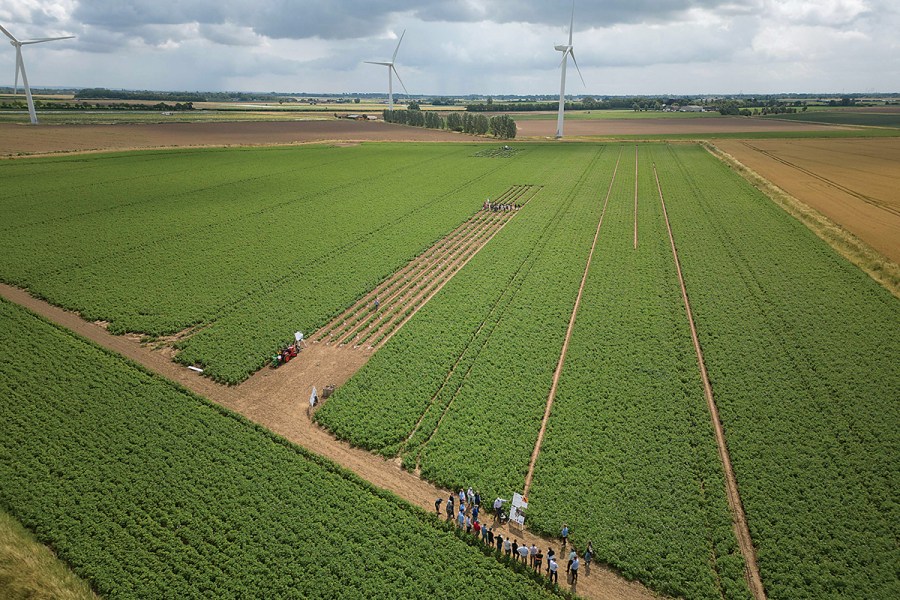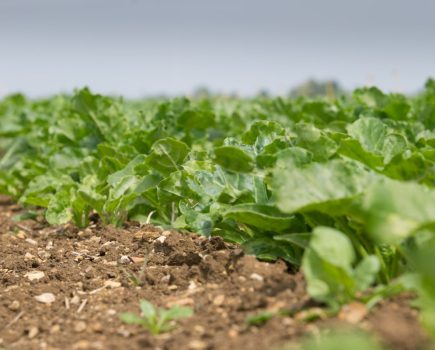Trials are vital to help overcome the challenges involved with growing a healthy and successful potato crop. CPM learns about some of the latest research from a Hutchinson’s demonstration day.
By Rob Jones and Melanie Jenkins
Through a series of trials held at A H Worth, Holbeach in Lincolnshire, Hutchinsons is aiming to help growers deal with many of the issues faced when growing potatoes. At a recent demonstration day, a team of experts took delegates through the work to examine how it could help with future crop management.
Some of the challenges associated with post-emergence weed control in potatoes includes safety issues related to specific varieties which can be affected by climatic conditions – something explored in the trials, explains Hutchinsons’ Darryl Shailes.
“We’re frequently contacted by our growers and agronomists to ask questions around herbicide safety, particularly around metribuzin and bentazone on new varieties, so this trial will help growers to assess any yellowing and/or loss of vigour so they can make better informed decisions,” he says.
The trial plots on the site were planted on 8 June with herbicides applied once crops were 15-25cm in height, using the best practice of evening spraying. “Some of the varieties have had some damage, so we’ll continue to monitor them to see whether they grow away.
A further trial being run by Hutchinsons has looked at varietal tolerance and resistance to potato cyst nematodes (PCN). Research into this is particularly poignant given the risk of losing Nemathorin (fosthiazate) in 2024, meaning crops could be exposed without the protection of the high-volume granular nematicide.
The trial involves monitoring 24 varieties, each selected for its resistance status, with Maris Peer used as the control. Plots were planted on 19 April and were divided into two, with one side treated with Nemathorin at 30kg/ha and the other without, and both were irrigated. The background PCN level in the field was 16 eggs/g, but on creating the plots this was then broken down into eggs/g per plot, which ranged from 0.5-20 eggs/g.
Simon Faulkner of SDF Agriculture observed that the variety Paradox is showing resistance as well as a degree of tolerance. Amanda also showed quite good tolerance, but in general the canopies were better where the soil had been treated with Nemathorin (fosthiazate).
He emphasised that results won’t be seen until after harvest when a population final/population initial factor (pf/pi) will be done, until then the observations can only reflect tolerance to PCN. And he flagged that ‘tolerance’ shouldn’t be confused with ‘resistance’, explaining that they aren’t linked.
“Tolerant means that a particular variety can still grow well even when under considerable pressure from PCN, so better canopies are only showing the level of tolerance. This is normally accounted for due to their extensive root system.
“When a variety is resistant, it means that nematode multiplication is reduced or prevented, decreasing the viable number of cysts which form. It’s a long-term strategy because the yield in that crop may be reduced if the variety isn’t tolerant.”
Tolerant varieties can result in significant increases in PCN, and the ideal is to have a resistant variety with a degree of tolerance, he says.
Of the varieties in the trial, he points out the new crisping variety Cinderella, which has resistance to both PCN species present in GB (Globodera rostochiensis and Globodera pallida), looked to be reasonably tolerant too. “This variety has relatively stable sugars and should go to mid-term storage.”
Packing variety Karelia has also been bred for resistance to both species, but looking at the canopy, its tolerance was not quite as robust, he notes.
Simon highlights that Buster is another useful variety as it requires less N inputs than many others, noting that the reason its canopy was still small may be because it’s a later maturing variety. “All these plots will be taken to harvest, and we’ll then analyse the final population of PCN so that a pf/pi can be calculated.
“A yield will be calculated from the plants removed from the plots and the tubers size graded into mid-size (<45mm), bakers (65-85mm) and ware,” he says.
“There’s a proposal to store the prepack varieties in a commercial cold store at 3oC and the processing and chipping varieties in a warm store at 8oC. There can then be some assessment on dormancy and quality stability during storage.” Results are expected to be available later in the year and presented at a later meeting.
This article was taken from the latest issue of CPM. Read the article in full here.
For more articles like this, subscribe here.
Sign up for Crop Production Magazine’s FREE e-newsletter here.




